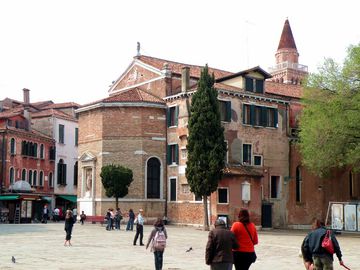

The Church of San Polo, Venetian for St. Paul, is an unusual structure. Looking at it closely, we realize that it lacks a front façade. The main entrance to the edifice is located at the side and instead of the facade, it is the back apse that juts out into the San Polo Square. We also see that the bell tower is so detached from the church that the space between the two was wide enough to form a street. In fact, the church's exterior is so unimpressive that the shrine can easily be unnoticed, and if it were not for the bell tower, we would not even consider the possibility of there being a religious building in the vicinity.
The original Church of San Polo was erected in 837. Yet, incredibly, after all the reconstructions carried out in the following centuries, the Byzantine-style three-nave floor plan has been preserved. The gothic ogival portal serving as the main entrance dates back to the 14th century. In the 18th century the apse was completely redone in the semi-octagonal form that we see today and certain neo-classical motifs were introduced in the interior's decoration.
As strange as it may seem, this highly unremarkable church, which lends its name to the entire sestiere, contains a formidable collection of works by many preeminent Venetian masters. On the left wall as we enter the church hangs the Last Supper by Jacopo Tintoretto, while further down, the Mary with saints altarpiece decorating the first altar was completed by his students. The left absidal chapel conceals the Marriage of the Virgin by Paolo Veronese, while the presbyter boasts three canvases by Jacopo Palma the Younger: St Peter and the Keys, St Paul at Tarsus, and Temptation of St Anthony Abbot. Next to the main altar we find two bronze statues by Alessandro Vittoria, St. Paul and St. Anthony Abbot. The ceiling presents some frescoes by the Tiepolo family: the Glory of Angels and the Resurrection by Giandomenico, and the Virgin appearing to St. John Nepomuk, by his father Gianbattista. In the Oratory of the Crucifix we find the Stations of the Cross, as well as several separate paintings of individual saints, also by Giandomenico Tiepolo.
Another fascinating detail can be found above the entrance to the bell tower, which was constructed in the 14th century. There we see two stone lions - one grabbing a snake, the other holding between its paws the head of a man. According to tradition, the head is supposed to be a sculpture of Marino Faliero, the 55th Doge of Venice, beheaded for high treason after having led a coup to unseat the Republican government and install a monarchy.
The square outside the church, known as Campo San Polo, happens to be the second largest square in the city after St. Mark's. In fact, all Venetian squares except St. Mark's are called campi, that is, fields. This is because until the 19th century they were not asphalted. Campo San Polo however was covered with a brick pavement in 1494, which gave it a warm color and a more practical purpose. It was always packed with people during carnivals and popular festivities, and often hosted the famous Bull Hunt. The Bull Hunt was a spectacle, similar to the modern corrida, but one in which bulls fought against dogs. The dogs, a large number of them, would attack one bull until it collapsed from the wounds and exhaustion and was finally put out of its misery by a swift stroke of the axe. This gruesome spectacle was outlawed only after the fall of the Venetian Republic in 1802, when a wooden tribune was knocked over killing many bystanders.
Today, during the summer, Campo San Polo hosts an outdoor cinema with a screen that is wider than the church itself. To get a free view you don't need to reside in one of the palaces overlooking the square. If you are clever, you can watch the movie from a bench or a tree stump. Besides, it's more romantic, and you can bring your own popcorn.